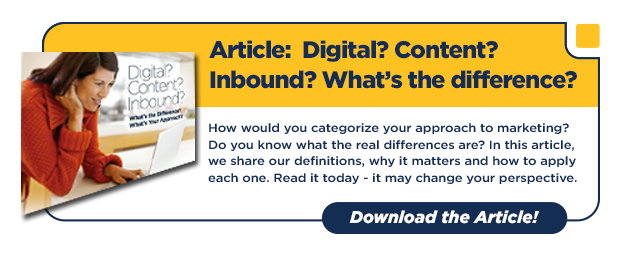 Confessions. Dirty secrets. White lies. Sounds juicy, right? But totally not applicable to inbound marketing…or is it?
Confessions. Dirty secrets. White lies. Sounds juicy, right? But totally not applicable to inbound marketing…or is it?
The inbound marketing ideology recently turned 10…with HubSpot. HubSpot and others have done a great job selling the ideology. The way they lay it out makes perfect sense. It causes “ah ha” moments. It is easy to get excited about it.
So you convince yourself and your marketing team that there is no other way to approach marketing and go down the path to implementing your own inbound strategy.
But soon…the Kool-Aid isn’t as sweet as it was.
If you’ve been out of college for more than ten years, chances are you began your career as a traditional marketer. You may STILL be what you consider a traditional marketer. That’s where I fall. The marketing world was an entirely different place than it is now for most of my career.
I first started learning about inbound marketing in late 2013. So, for me, inbound marketing is about three years old and I have only been fully “practicing” it for less than two years.
While I love inbound marketing, there are things about it that have been and continue to be very challenging. My significant experience as a traditional marketer has been helpful and has also felt like a burden. I sometimes find myself feeling very alone in my frustrations and challenges but I know I’m not alone. That’s why I decided to confess…to share the things that frustrate me behind my “I love what I do” smile. Hopefully this well help someone else who feels similar frustrations learn how to get through them and keep your eye on what really matters…results.
I believed inbound marketing would be all sunshine, lollipops and rainbows…and it’s not.
Let me start here. From the first day I learned about inbound marketing, I loved it. I loved everything about it. It made absolute sense. It sounded like marketing utopia. I believed if we implemented an inbound marketing approach, everything WOULD be sunshine, lollipops and rainbows.
Guess again. Inbound marketing is really hard work. There are a lot of pieces to the puzzle and a lot of things that can go wrong. Additionally, success does not happen overnight. It is possible for it to take several months to start reaping the benefits of all of your hard work.
What I’ve learned is that sticking to the approach will eventually bring the rewards. Don’t give up. If you build a solid strategy and execute it, it will work. You may have to tweak it along the way but that’s part of the beauty of it. Tweaking is easier than with a traditional approach and cheaper.
Also, don’t wait until the stars are all perfectly aligned. Just get started. And remember, you have to have some rain in order to see a rainbow.
I hate social media.
Yes. It is true. I hate social media. Just saying it out loud (or in this case typing it for the world to see), makes me feel better. There is simply nothing natural about social media for me.
That’s why I shunned it, from a professional perspective, for several years. I didn’t see the value in social media for B2B companies. In my opinion, social media was designed for college kids and teenagers - not business professionals.
Turns out, I was wrong. Social media does have a place in B2B marketing. I can’t imagine implementing our strategy without it. In my experience LinkedIn and Twitter, in particular, are the most effective. And we’re about to start experimenting with Facebook; and I hear a bunch of B2B people talking about the benefits of Snapchat.
If you’re like me and really aren’t comfortable with social media, that’s ok. You don’t have to be a social media junkie to learn how to use it effectively for business. Do your homework. Find resources – there are many available – that will help you get started or that will help you improve your current approach.
The lesson here is that it is ok to dislike it…but you do need to embrace it for the power it can have for your marketing efforts.
The content monster is scary.
When I think back to my traditional marketing days, we created a lot of content. Quarterly newsletters, case studies, brochures, proposals, articles, web copy…the list goes on and on. But back then, I never, ever thought about content as a monster, let alone a scary monster.
Content is the fuel that feeds an inbound marketing effort. How do we help our buyer personas? We provide them valuable content that teaches them something useful to them…on a regular basis. Blog posts, whitepapers, ebooks, infographics, video, email, social media…the list goes on and on.
The difference in content creation is the volume of content that needs to be published on a consistent basis. Inconsistency in content publication can be the difference between success and failure.
For Imagine, that means three blog posts per week for us plus more to publish elsewhere. It also means multiple pieces of premium content per month. There are always multiple pieces in production at all times. It never ends. There is no end to content creation.
That’s why it is scary. If we fall off on content production, the effects are felt throughout our demand generation effort.
What I have learned is that the scary monster that is content, can be managed. Being strategic and thoughtful about how you produce content will help you calm the monster. One of the tools we use is a content map. It helps us track what we’ve created for who and where it applies to the buyer’s journey. We also use Trello to help us manage our blog and editorial calendar.
Don’t let content leave you feeling overwhelmed. Figure out the best way to manage it for your team and you’ll feel less scared.
I thought I had to leave traditional marketing behind.
There are things about traditional marketing that I really love. For example, I have always loved trade shows and events. When done well and when strategy is applied, they can yield fantastic results. And...I just think event planning is really fun.
When I first started really practicing inbound marketing, I believed I had to leave the traditional behind. After all, inbound was going to help us market specifically to people who were already interested and wanted to buy from us. It is obviously most cost-effective to focus there – on the people who have identified themselves.
To me that meant, forgetting PPC, print ads of any kind, trade shows and events. It also meant I could forget about outbound and that made me happy.
Truth is, I was wrong…very wrong. Inbound marketing is a strategy that can yield great results but implementing it doesn’t mean other strategies will stop yielding results. The trick is figuring out how it all works together.
Start where you always do…with the goals and objectives of your organization and build a strategy from there. Do not forget about your traditional experience and what has worked in the past. Use it with your inbound approach. Use what you’ve learned in traditional marketing to help guide you…it’s not all wrong. It is just different.
If inbound really meant forgetting traditional, most companies wouldn’t be able to justify the cost of a marketing manager, right? Think about that next time you’re dismissing traditional marketing.
Is inbound marketing everything I dreamed of? Overall, yes. Have I gotten some bumps and bruises along the way? Again, the answer is yes. In fact, I’m still getting them. Anything worth doing is hard work. Nothing is as easy as it seems. Roll up your sleeves, know you’re not alone in your frustrations and get moving. If the sweetness doesn’t return to your Kool-Aid, then you’re doing it wrong.

